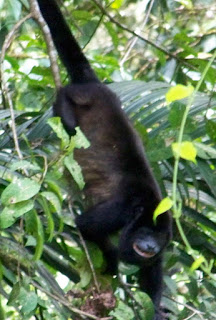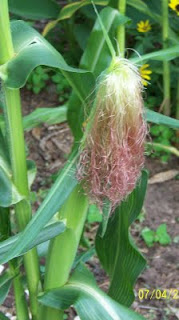
 I am not into "extreme" anything, and certainly not sports. My style is more moderate hikes and long walks. But, we just could not resist a Zip Line through the rain forest canopy.
I am not into "extreme" anything, and certainly not sports. My style is more moderate hikes and long walks. But, we just could not resist a Zip Line through the rain forest canopy.I did not know much about zip lining, other than it is a fast ride on a cable. So, let me describe it. To begin with, you need to have an elaborate harness. This consists of a wide belt around your waist. Attached are two more harnesses, one for each thigh. The three are joined by a large steel buckle. The staff begins by putting you in the harness. They then fit you with a helmet and hook a large pulley, which has handles on each side, to the side of your harness, and hand you a ratty pair of work gloves. Ours were those blue and grey kind that you see in the hardware store.
After our group (there were 8 of us) were all fitted out, we road a tram about a mile up the mountain. At the first platform we were at an elevation of about 3500' . It was a nice, slow ride up through the canopy. We then got off on the platform where the guides gave us a brief instruction on how to ride the zip line. Here is how it works. You step up on a riser and the guide takes the pulley off your belt and hooks it onto the cable. He then hooks it to the large buckle on your harness and tells you to 'sit down' and to hold onto the handles on your pulley. At this point you are basically on your back, hooked to the cable and supported by the harness. Yup, you are hanging in the air by harnesses around your waist and thighs holding onto the pulley. They tell you to cross your ankles and tuck your legs up, so you are in a fetal position. Then you are given a push and off you go! Whee! As you get near the next platform, one of the guides shakes the cable, letting you know to brake. You brake by stretching out your legs and gently moving the pulling back and forth. They have a rope attached to the cable that 'catches' you, and then the guide pulls you onto the platform. You do a very short 'practice' run, but then they put you on the first cable so quickly you don't have time to think about chickening out. After that you have one chance to quit. No one in our group did.
There are 8 lines. The shortest is 120 ft and the longest over 2300 ft. I don't actually know how fast you go, but I have read that it is up to 50mph. It is advertised that you can see birds and animals, but you can't really. You are moving so fast that you can't observes much of anything except the tree tops. On the next to the last line, it goes pretty low, so that you are going through a cut in the trees, almost like being in a tree tunnel.
I have never done anything that made my heart race so much. It was a great experience. I'm not sure I would do another zip line, but I might.






































